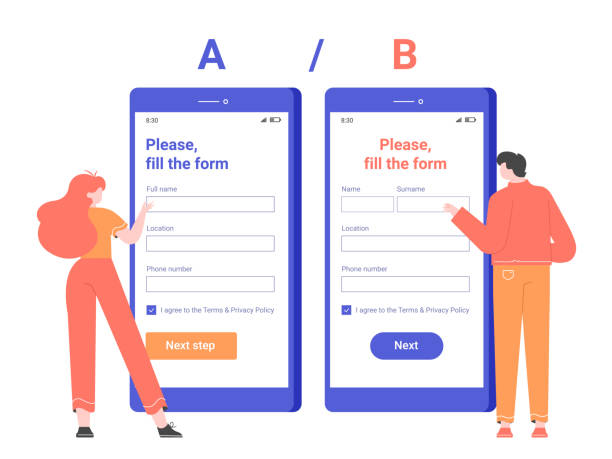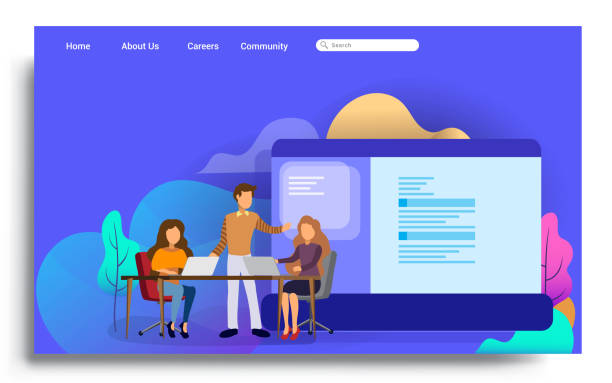Introduction to the Importance of Secure Website Design

In today’s world, where the complexities of the Internet are increasing daily, the concept of secure website design has become more vital than ever.
Websites are not only showcases for businesses and informational platforms but also repositories for sensitive user data and sometimes critical infrastructure for commercial operations.
Ignoring Web Security can lead to devastating cyberattacks, data loss, reputation damage, and heavy financial losses.
This educational section helps you gain a deeper understanding of the necessity of secure website design.
Our main goal in this article is to provide a comprehensive and explanatory guide that helps developers, website administrators, and even ordinary users become familiar with existing security challenges and implement effective solutions to counter them.
With the increasing complexity of Cyber Attacks, only a Secure and Robust Website Design can withstand threats and ensure the Protection of User Information.
The more sensitive data your website manages, the greater the need to adhere to higher standards in secure website design and protection.
These measures are essential not only for data preservation but also for compliance with privacy laws and regulations.
Did you know that 85% of customers check your company’s website before any interaction?
With RasaWeb, build a corporate website worthy of your credibility.
✅ Increase credibility and customer trust
✅ Attract high-quality leads
⚡ Get free website design consultation
Identifying Common Website Vulnerabilities

To achieve a secure website design, we must first become familiar with the most common weaknesses and vulnerabilities that attackers exploit.
This specialized section analyzes the most common web threats.
One of the most well-known vulnerabilities is SQL Injection, which allows an attacker to inject malicious SQL code into application inputs and gain access to the database.
Another is Cross-Site Scripting (XSS), which enables the injection of client-side script code (such as JavaScript) into web pages and can lead to the theft of cookies or user information.
Vulnerabilities related to Session Management are also very important, where an attacker can hijack a user’s session and gain access to their account.
XXE (XML External Entities) attacks and insecure deserialization are also serious threats that can lead to remote code execution.
In a secure website design, these vulnerabilities must be continuously identified and remediated.
Furthermore, weaknesses in access control, uploading malicious files, and misconfigurations of servers and software are other factors that put websites at risk.
Accurate knowledge of these weaknesses is the first step towards strengthening security foundations and implementing a secure and reliable website design.
This knowledge forms the basis of any powerful defensive strategy.
Principles of Secure Coding and Best Practices

After identifying vulnerabilities, the next step in the path to secure website design is implementing secure coding principles.
This practical guidance section provides for developers to write code that is resistant to attacks.
The first and most important principle is rigorous validation of all user inputs.
Every piece of data received from the user must be checked to ensure it matches the application’s expectations in terms of type, length, and content.
Using appropriate filtering and escaping functions is essential to prevent code injection and XSS.
Parameterizing SQL queries (prepared statements) instead of directly concatenating strings prevents SQL injection.
Furthermore, secure error handling and logging are of high importance; sensitive information should not be disclosed in logs, and error messages should not provide too many system details that could assist an attacker.
Using modern and up-to-date frameworks that have built-in security mechanisms can significantly contribute to secure website design.
Not storing passwords in plain text and using strong hashing (such as Bcrypt or Argon2) to store them is a requirement.
Additionally, using HTTPS for all web communications, encrypting sensitive information during storage, and adhering to the Principle of Least Privilege for users and processes are other key principles.
Attention to these details throughout the development process is the cornerstone of a secure website design.
Below you will find a table of important security practices in coding:
| Security Principle | Brief Description | Example Application |
|---|---|---|
| Input Validation | Thorough checking of all input data from the user. | Filtering special characters in forms. |
| Using Parameterization | Separating data from SQL codes. | Using Prepared Statements for database queries. |
| Password Hashing | Irreversible encryption of passwords. | Storing passwords with Bcrypt or Argon2. |
| Implementing Principle of Least Privilege | Granting the minimum necessary access to users and processes. | Restricting user access to files and directories. |
| Using HTTPS | Encrypting traffic between user and server. | Installing SSL/TLS certificate on the server. |
Database Security and Protection of Sensitive Information

The database is the beating heart of any website, containing the most valuable information, including user data, transaction records, and confidential details.
Therefore, a secure website design would be incomplete without special attention to database security.
This specialized section addresses database protection solutions.
The first step is strict access control; only authorized users and processes should have access to the database, and only with the minimum necessary privileges.
Using separate user accounts with strong, rotating passwords for each application and database user is essential.
Encrypting sensitive data at rest and in transit is of high importance.
For data at rest, internal database encryption capabilities or file system-level encryption can be used.
For data in transit, using secure protocols like SSL/TLS for database connections is mandatory.
Database security patches and updates must be applied regularly to address known vulnerabilities.
Separating the database from the web server within a secure network (such as using a VPC or private Subnet) adds an extra layer of defense.
Regular and encrypted backups of the database are vital for information recovery in the event of a security incident.
Finally, conducting periodic security audits and monitoring database activities to identify suspicious patterns and intrusion attempts are necessities for a secure website design.
By observing these points, sensitive information can be protected against unauthorized access.
Losing potential customers due to an unprofessional website? RasaWeb is your answer! With our specialized corporate website design services:
✅ Enhance your business’s credibility and standing
✅ Experience attracting more targeted customers
⚡ Act now to receive a free consultation!
Effective Authentication and Authorization

One of the main pillars of secure website design is the correct implementation of Authentication and Authorization systems.
This educational section shows you how to securely manage user access.
Authentication is the process of verifying a user’s identity, while authorization determines what resources the authenticated user has access to.
For authentication, using strong passwords and mandatory password change policies is essential.
Implementing two-factor authentication (2FA) or multi-factor authentication (MFA) is a very important security step that protects the user account even if the password is compromised.
Limiting unsuccessful login attempts to prevent Brute-Force attacks and using CAPTCHA are also recommended.
For authorization, Role-Based Access Control (RBAC) models should be used, which grant specific permissions to users based on their roles in the system.
Each user should only have access to the resources they need to perform their tasks.
This is the principle of least privilege, which is very important in secure website design.
The correct implementation of these two mechanisms prevents unauthorized access to sensitive parts of the website and data.
Also, Session Management is an integral part of this process; sessions should have a limited lifespan, random and unpredictable session IDs, and should expire after user logout or prolonged inactivity.
These precise approaches provide the foundation for a secure and reliable website design.
Network Security and Server Infrastructure

Website security is not limited to coding and databases; network and server infrastructure also play a vital role in secure website design.
This specialized section addresses infrastructural aspects of security.
Proper configuration of the web server (such as Nginx or Apache) and database server, as well as the operating system, is of paramount importance.
Removing unnecessary services and modules, disabling unused ports, and using a Firewall to control inbound and outbound traffic are among the initial measures.
A strong firewall can prevent DDoS (Distributed Denial of Service) attacks and network intrusion attempts.
Using Intrusion Detection Systems (IDS) and Intrusion Prevention Systems (IPS) to monitor network traffic and identify suspicious patterns provides an additional layer of security.
Furthermore, regular management and updating of the operating system, libraries, and all software installed on the server are essential to address known vulnerabilities.
Using Content Delivery Networks (CDN) not only increases website loading speed but also helps protect against DDoS attacks by distributing traffic.
Network Segmentation, placing different website components (such as web server, database server, and backend) in separate subnets with specific firewall rules, prevents the spread of an attack if one section is compromised.
These comprehensive approaches at the network and infrastructure level form the backbone of a secure and sustainable website design, and any disregard for them can render all your efforts to secure the code ineffective.
Security Audits and Continuous Updates

A secure website design is not a static process; rather, it requires continuous attention and updates.
This news and analytical section addresses the importance of maintaining and enhancing website security.
Security threats are constantly changing and evolving, so your website must evolve with them.
Conducting regular security audits, including Penetration Testing and Vulnerability Scanning, is essential for identifying new or overlooked weaknesses.
These tests can be performed by an internal team or external security specialists.
A plan for applying security patches and updates for all software, frameworks, plugins, and operating systems should be routinely implemented.
Many successful attacks are the result of exploiting known vulnerabilities for which patches have long been released but not applied.
Monitoring server and application logs for suspicious activities is also crucial.
Using Security Information and Event Management (SIEM) systems can help consolidate and analyze logs, providing timely alerts.
A secure website design requires a cycle of continuous improvement.
Additionally, having an Incident Response Plan (IRP) and regularly testing it prepares the website to deal with potential attacks.
A culture of security must be embedded throughout the organization, from developers to administrators and end-users.
Paying attention to new security news and reports and promptly implementing security recommendations can prevent many incidents from occurring.
Below you will find a table of common security auditing tools:
| Tool/Method | Main Application | Known Example(s) |
|---|---|---|
| Vulnerability Scanner | Automatic identification of weaknesses in applications and infrastructure. | Nessus, OpenVAS, Acunetix |
| Penetration Testing (PenTest) | Simulating attacks to discover operational vulnerabilities. | Metasploit, Burp Suite (for web) |
| SIEM Systems | Aggregating and analyzing security events from various sources. | Splunk, ELK Stack (Elasticsearch, Logstash, Kibana) |
| Bug Bounty Programs | Rewarding ethical hackers for discovering vulnerabilities. | HackerOne, Bugcrowd |
| Static Application Security Testing (SAST) | Analyzing source code to discover vulnerabilities before execution. | SonarQube, Checkmarx |
The Role of User Education in Website Security

Even with the best secure website design and the strongest infrastructures, the human element can be the biggest weakness.
This educational and entertaining section addresses the importance of educating end-users and employees.
Users must be aware of the dangers of phishing, social engineering, and malicious links.
Many attacks begin by tricking users into revealing login information or downloading malicious software.
Educating users about choosing strong passwords, identifying suspicious emails, and avoiding clicking on unknown links can significantly improve the overall security of the website.
For internal employees, regular training on company security policies, how to report security incidents, and the importance of protecting sensitive information is crucial.
They must know how to work securely with data, protect personal devices, and avoid insecure public networks.
Conducting workshops, sending security newsletters, and running simulated phishing tests are effective methods to increase employee awareness and preparedness.
A secure website design is not just a technical perspective; it is a collective effort where every individual in the chain of interaction with the website plays a role.
User awareness and vigilance can create a layer of defense that no firewall or intrusion detection system can replace.
By investing in user education, you have effectively invested in strengthening all aspects of your website’s security.
Did you know that poor online store design can drive away up to 70% of your potential customers? RasaWeb revolutionizes your sales with professional and user-friendly e-commerce website designs.
✅ Significant increase in sales and revenue
✅ Full optimization for search engines and mobile
⚡ [Get a free consultation from RasaWeb]
Planning for Security Incident Response and Recovery

Despite all efforts for secure website design, the possibility of security incidents always exists.
This explanatory and analytical section focuses on the importance of having an Incident Response Plan (IRP) and Recovery processes.
A good IRP includes specific steps for identification, containment, eradication, recovery, and lessons learned from incidents.
The first step is rapid incident identification and scope assessment.
Monitoring and logging systems should be configured to provide timely alerts.
After identification, the next goal is to contain the attack to prevent further damage; this may include disconnecting compromised servers or blocking suspicious traffic.
Then, eradication of the threat means removing the intrusion agent (such as malware or a hacked user account) and patching the vulnerability.
The recovery phase involves restoring systems to normal operational status using secure backups and thorough testing to ensure the problem is fully resolved.
Finally, the lessons learned and review phase is very important; the team must analyze the incident, identify root causes, and implement preventive measures to avoid its recurrence in the future.
This process helps in the continuous improvement of secure website design.
Having regular and reliable backups of data and code is a vital element in any recovery plan.
These backups must be encrypted and stored in a secure location.
Periodically testing the incident response plan through simulated exercises (Tabletop Exercises) helps the team to act more prepared in real-time and prevent chaos.
Future Trends in Web Security

The world of secure website design is constantly changing, and predicting future trends is vital for maintaining website security.
This thought-provoking and analytical section addresses the new horizons of web security.
With the expansion of Artificial Intelligence (AI) and Machine Learning (ML), we will witness the emergence of more advanced security tools capable of identifying complex attack patterns and automatically reacting to threats.
These technologies can play a significant role in detecting anomalous user behavior, filtering malicious traffic, and even predicting vulnerabilities before they are exploited.
Blockchain can also revolutionize decentralized authentication and digital identity management, where users will have more control over their personal data, and the risk of data breaches on central servers will decrease.
API security will gain more importance with the increased use of microservices and public APIs.
More secure protocols and stricter access management for APIs will be necessary.
Furthermore, quantum computing can create new challenges for current encryption algorithms; therefore, research into Post-Quantum Cryptography is increasing.
The rise of Supply Chain attacks and vulnerabilities in open-source software also necessitates that developers and companies pay special attention to the security of their code’s external dependencies.
Finally, secure website design in the future will move more towards “Security by Design” and “Privacy by Design” approaches, where security and privacy are considered from the very initial stages of the software development lifecycle.
Frequently Asked Questions
| Question | Answer |
|---|---|
| What is secure website design? | Secure website design is a process where websites are built with security principles in mind to be resistant to cyberattacks and to protect user and business information. |
| Why is secure website design of high importance? | To prevent unauthorized data access, sensitive information leaks, malware attacks, loss of user trust, damage to business reputation, and legal consequences resulting from data breaches. |
| What are the most common website vulnerabilities? | SQL Injection, Cross-Site Scripting (XSS), Cross-Site Request Forgery (CSRF), broken authentication and session management, and sensitive data exposure. |
| How can SQL Injection attacks be prevented? | Using Prepared Statements with parameterized queries, input validation, and restricting database access. |
| What are the methods to counter XSS (Cross-Site Scripting) attacks? | User input validation, output encoding before displaying in HTML, and using Content Security Policy (CSP). |
| What is the role of HTTPS in website security? | HTTPS encrypts the communication between the user’s browser and the website server using an SSL/TLS certificate, preventing eavesdropping, tampering, or forgery of data. |
| What are the best practices for user password management? | Enforcing strong passwords (a combination of letters, numbers, and symbols), hashing passwords instead of storing them directly (with strong algorithms like bcrypt), and enabling two-factor authentication (2FA). |
| What is the importance of user input validation? | Input validation prevents the entry of malicious or unexpected data into the system, which can lead to vulnerabilities such as SQL Injection or XSS. |
| What impact do regular security reviews and audits have on site security? | These reviews help identify vulnerabilities and security weaknesses early, allowing them to be addressed before they can be exploited. |
| What is the application of Web Application Firewall (WAF) in secure website design? | A WAF acts as a protective layer between the user and the website, analyzing incoming traffic, and identifying and blocking common web attacks like SQL Injection and XSS. |
And other services of RasaWeb Advertising Agency in the field of advertising
Smart Advertising Campaign: Professional optimization for customer acquisition using key page optimization.
Smart Link Building: A specialized service for improving SEO ranking based on Google Ads management.
Smart SEO: A specialized service for growth through customer behavior analysis based on intelligent data analysis.
Smart Custom Software: An effective tool for customer acquisition with the help of SEO-driven content strategy.
Smart Data Analysis: An innovative service for increasing website traffic through the use of real data.
And over hundreds of other services in the fields of internet advertising, advertising consulting, and organizational solutions.
Internet Advertising | Advertising Strategy | Advertorials
Resources
WordPress Site SecurityHow to design a secure website?Increase Website StabilityComplete Guide to Website Security
? Are you looking for significant business growth in the online space? Rasaweb Afarin, with unparalleled expertise in digital marketing, from fast and optimized website design to comprehensive SEO strategies and content production, is your comprehensive solution for visibility and attracting more customers.
📍 Tehran, Mirdamad Street, next to Bank Markazi, Kazerun South Alley, Ramin Alley No. 6




